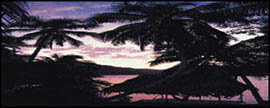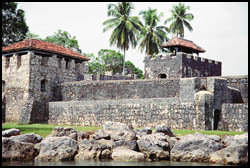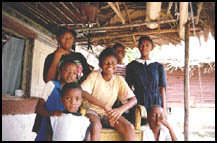 CARIBBEAN COAST CARIBBEAN COAST |
Typically tropical and wonderfully Guatemalan are ideal phrases that describe the Caribbean coast. Travelers have the option of visiting misty mountain cloud forests to the balmy, coastal regions of the Caribbean.

Guatemala's Caribbean coast is an exciting blend of tropical forest and mangroves, incredible sunsets and top it all off with the spice of the Garífuna culture. Have a taste of life on the waters of Lake Izabal, Río Dulce and the Caribbean sea!
During the late 1800s, this region bustled with the activity on banana plantations. Barges made their way down from the shining waters of Lake Izabal to Río Dulce and out past Livingston. Today the area continues to be economically busy but it is now complimented with a healthy influx of sailboats and visitors. The sunny days and the beautiful surroundings convince passersby to spend a few extra days. The sea breeze and a chilled coconut will have you swinging in a hammock in no time.
By following the Atlantic Route you'll find yourself passing through a variety of landscapes. You'll travel along the road with the Sierra de las Minas mountain range to the north and the Sierra del Merendón to the south. The road to the ocean has many treats for visitors along the way. Spectacular scenery, Maya ruins, lakes and manatees are just a few of the things to look out for.
Just past the town Los Amates, you'll find the ruins of Quiriguá. They lie just a few kilometers outside of the town with the same name. The intricately carved stelaes are similar in style with those found in the Honduran ruins of Copán. Consequently, archaeologists believe it possible that the two cities communicated via the river.
As the majestic Sierra range blends into the land, Lake Izabal glitters on the horizon. It measures 30 miles in length and 12 miles in width. Naturalists will love spending time in the area. The mangroves provide good homes for alligators, turtles, tarpon and plenty of marsh birds.
At its eastern end, Izabal begins to channel into Río Dulce and the national park by the same name. This is marked by the Castillo de San Felipe. Left over from the days of marauding pirates, the fortress dates back to the mid 1600s. It was built in an effort to keep the looting swashbucklers out of the lake and away from shipments of gold, cacao and indigo. It can be reached either by land or by boat and is a great place to spend a few hours of quiet exploration.

Río Dulce has several marinas catering to an international sailing crowd. Along with the marinas, several good hotels and restaurants have cropped up. From a good meal to supplies, the Rio Dulce area has it all. A large expatriate community calls the area home and is intent on providing all the amenities for visiting boats and landlubbers alike. Tide charts, river regulations and boats for hire make up an extensive information system on the area.
Río Dulce, the "sweet river", flows into El Golfete and the Biotopo de Chocon Machacas Reserve. It was established to protect the fresh-water manatee that resides in the area. They are hard to spot but the creatures are said to be less elusive during the month of May.
The river winds its way down to the Bahía de Amatique through a small canyon.
The rock walls overhang with tropical vegetation and the sounds of the birds echo throughout. It is a beautiful, solitary experience made enjoyable by the spectacular surroundings. A good guide will point out the hot water springs pooled just alongside and the kingfisher perched on a branch. Canoe and kayak trips are being run by local operators and provide good tours of the area.
Overlooking the bay sits the tropical town of Livingston. The town is perched on a small bluff on the ocean's edge. Here visitors can revel in truly tropical surroundings. Visitors have their choice of hotels depending on the setting they're looking for. Whether it's a splashy resort or a quaint bed and breakfast, visitors will find it here. There are a few hotels setting up their operations a few kilometers outside of town right on the beach.
This area is populated by the Garífuna people, descendants of Carib indigenous and escaped African slaves. The Garífuna fill the town with their rich culture and musical language. Livingston is unique in all of Guatemala for its Garífuna population.
There are plenty of activities here to take up a few days so kick back and enjoy the laid-back atmosphere. You won't feel a twinge of guilt as you take in the beauty of Siete Altares. This series of fresh water pools lies just outside of Livingston and daily outings are guided there by local operators. Hit the rolling surf in a sea kayak and paddle out on the waves under frigate birds and pelicans. | Take a day trip out to the small community on Punta Manabique. A short boat ride will take you out to the white-sand beach and blue waters of the ocean. Take in the sunset on the wooden pier and enjoy Guatemala's Caribbean coast to the fullest!
 The Garífuna The Garífuna |

The origins of the Garífuna intermingle with the cultures of the Carib and Arawak indigenous people of the Antilles islands. British ships carrying Africans destined for slavery floundered and sank off the coasts of Caribbean islands. One such island that offered sanctuary from slavery was St. Vincent.
There are many Garífuna communities along the Caribbean coast of Central America, the largest is found in Honduras. Guatemala's Garífuna community in Livingston is strong in its heritage and traditions. Holiday celebrations and religious festivities are carried out with a singular passion characteristic of their rich African heritage.
The loud beating of drums moves onlookers to clapping and keeping time with their feet. The firelight illuminates wide smiles and eyes bright with enthusiasm. A young woman begins to dance rhythmically with small steps towards the drums. Only a moment passes before a young man joins her. He dances before her while shouts of encouragement are thrown out by the crowd. They are dancing "punta", a Garífuna dance.
Punta is possibly the most popular and well known of the Garífuna's celebratory activities. Believed to be crucial for fertility, punta is a sensual and rhythmic dance most often performed by women. Punta is danced at social gatherings and other special occasions. Yankunu or Wanaragua is a dance reserved for men wearing fierce masks and is representative of their warring ancestors.
Their artistic inclinations are also evident in their pursuit of woodcarving. Using woods such as oak and cedar, they carve religious figures of saints that are carried through the streets in processions during Easter Week.
When visiting Livingston, take the time to wander around and explore the town. Its architecture is typically tropical with many houses boasting wide spanning windows and doors that catch even the slightest hint of a breeze. Wide porches are often occupied by elderly residents who sit and watch the comings and goings of the community.
Stop in at any of the small cafés or restaurants and catch up on local lore and customs with a friendly store owner. Much of the town's character relies on the intense hospitality of the Garífuna and it is this quality that makes Livingston such a treat to visit. If you're staying at one of the larger hotels, ask the front desk for a local guide. They will take you on a nice tour of the town where you may see some of the town's oldest houses and get an insider's look at the town's unique culture. The Garífuna are integral part of Guatemala's cultural mosaic. Visit Livingston and get a taste of Guatemala's unique Caribbean spice.
 How to get there How to get there |
The Ruta Atlántica runs northeast out of Guatemala City. It runs practically straight out to the ocean with several offshoots that can take you to many towns. Driving to Izabal from the city takes about five hours and if you're headed all the way to Livingston, plan on a good eight hours. Although there are several towns along the way, pack water and snacks for the drive.
 Climate Climate |
The average daytime temperature on the coast ranges from 80 to 90F. Even during the country's rainy season from May through October, the warm weather stays. The showers tend to bring the temperatures down a bit. Cold fronts have been known to enter off the ocean during the months of December and January but these temperatures descend to the mid 60s. When the rains come, it is wise to have rain gear on hand. But during the sunny months, you can make it with only a hat and sunglasses as extra gear! Don't forget the sunblock, either.
 Getting Around Getting Around |
Depending on where you're headed, travel in the area is either by land or by boat. The Ruta Atlántica snakes all the way out to the ocean and ends up at Puerto Barrios. Roads lead off the main highway to several towns along the way. By boat you can travel all the way up the Río Dulce to Livingston.
All these informations are provided by courtesy of Destination Guatemala and Sol y Luna |

